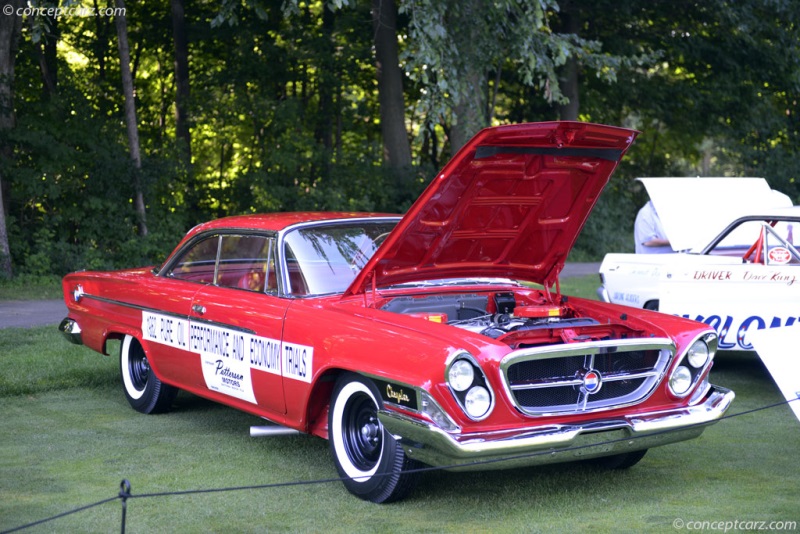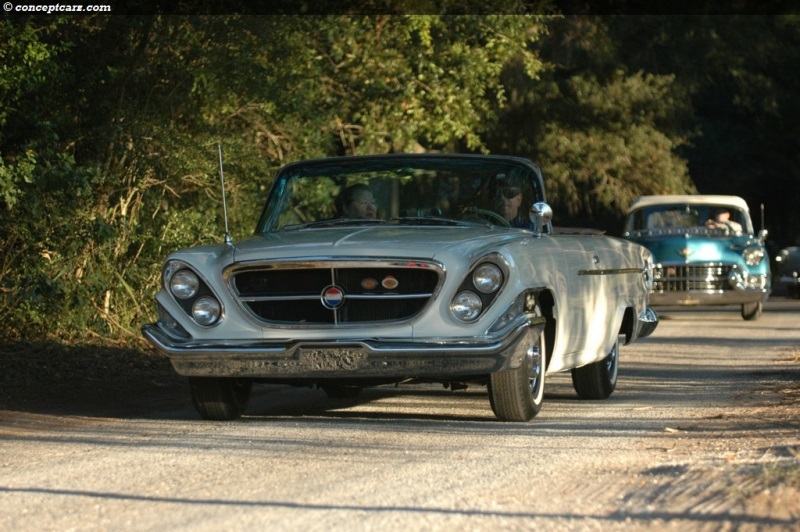The 1950s were an exciting time for the American automobile industry with many manufacturers going in very different styling directions. Chevrolet had their lightweight Corvette sports cars; Ford had their Thunderbird 'personal car.' Chrysler chose to introduce the 300 Series. This was a luxuriously equipped high-performance sporting sedan that later became a coupe and convertible. The engine was a Hemi V8 that had a performance camshaft mated to stiff valve springs and dual four-barrel carburetors; in later years, the powerplant was a Wedge Head unit. 
Convertible Hardtop
View info and historyThe Chrysler 300H was a dramatic departure from the opulent and excessive styling of the period. The previous flamboyant fins were nearly completely gone and replaced by a smooth cascading rear deck lid. The exterior and interior brightwork remained mostly intact, as well as the lavishly appointed interiors. They remained fast, exclusive, and luxurious. The Chrysler 300H no longer shared its platform with the New Yorker line. The wedge-head V-8 engine provided ample performance and ride control. Andy Granatelli took a 300H to another 'Flying Mile' record at Daytona, recording a 179.4-mph speed. During the year, a total of 558 cars were built and sold that year, with 435 of those built in hardtop coupe form. The decline in sales is attributed to the Sport Series 300, which came equipped with nearly everything found on the 300H as standard or optional equipment. The Sport Series 300 was significantly less expensive than its 300H sibling. 
Convertible Hardtop
View info and historyPricing for the 300H hardtop coupe began at $5,100, while the convertible sold for $5,450. Tan leather interiors were standard, with special order colors optionally available. Several high-performance engine options were available, with the inline, dual-carbureted engine being standard.Mechanical Specification
The 1962 Chrysler 300H (along with the Newport, 300 (non-letter), and Sport Series) was built on a 122-inch wheelbase and had an overall length of 214.9 inches. (The New Yorker had a 126-inch wheelbase and was 219.3 inches in length, with the station wagon slightly longer at just over 220 inches). The suspension was independent at the front with torsion bars and a live rear axle with leaf springs. Drum brakes were at all four corners. The 413.3 cubic-inch eight-cylinder engine had overhead valves, solid valve lifters, two Carter four-barrel carburetors, five main bearings, 10.1:1 compression, and delivered 380 horsepower at 5,200 RPM. The engine was paired with a three-speed TorqueFlite automatic transmission. Chrysler 300 Letter Series
The Chrysler 300 'letter series' was produced from 1955 to 1965, with 16,981 units built during that time. An additional 501 'Hurst' 300 examples were built in 1970 but lacked the single-letter suffix of its forebears. The first of the letter series was the C-300 of 1955, with the 'C' designation applied to all Chrysler models and the '300' referenced its 300 horsepower engine. Built for homologation purposes, the OHV FirePower Hemi V8 displaced 331 cubic inches and used dual four-barrel carburetors. It had a race-profiled camshaft, two overhead valves per cylinder, and solid valve lifters.
Hardtop CoupeStyling featured Virgil Exner's '100-Million Dollar Look,' and standard amenities included back-up lights, an electric clock, and two-speed windshield wipers. The 1956 Chrylser 300B had similar styling to the previous year, and engine options included a 354 CID Hemi V8 with 340 horsepower or a higher compression version delivering 355 horsepower. This was the first American production car to top 355 horsepower. For many years, the 'letter' series was the most powerful car produced in the United States.For 1957, Chrysler introduced the 'second' generation of the 300 letter series (now called the 300C), which would continue (with annual updates) through 1959. The engine displacement grew to 392 cubic inches, with output now measuring 375 horsepower. Eighteen examples were built in higher states of tune, with an output of 390 horsepower. This was the first year for the red, white, and blue '300C' circular medallions on the sides, trunk, hood, and interior. A new torsion bar front suspension, called Torsion-Aire, replaced the previous coil spring setup. A new optional AirTemp air-conditioning system was priced at $495.
Hardtop CoupeThe 1958 model year marked the end of the FirePower Hemi in the 300 (1958 300D). The displacement remained at 392 cubic inches, but output increased by 5hp (to 380 hp). The 392 cubic-inch engine was solely used on the 300 and Imperials. Thirty-five examples were given an optional Bendix 'Electrojector' fuel injection system. Installed in the 392 CID V8, the output was 390 hp. At the Bonneville Salt Flats, the 300D reached a top speed of 156.387 mph. At the Daytona Flying Mile, it achieved a quarter-mile time of 16 seconds at 94 mph. 1959 was the final year for the body-on-frame chassis construction, the final year for the styling language introduced in 1957, and the introduction of the Golden Lion wedge-head V8 displacing 413 cubic inches and producing 380 hp.
Hardtop CoupeThe 'third generation' of the 300 'letter series' arrived in 1960 with the 300F, with styling penned by Virgil Exner. The 413 cubic-inch Wedge Head 'Cross-Ram' V8 engine delivered 375 horsepower, and to increase power at lower and mid RPMs, it used a special intake manifold. A 'short ram' version, intended for competition, delivered 400 horsepower. The interior included four leather bucket seats with the front having swiveling capability and a new AstraDome instrument cluster with 'Panelescent Lighting.' The unibody construction helped reduce overall weight, and the styling featured sharper edges and outward-tilting fins. In the back was a 'Continental'-style trunk lid.The 1961 Chrysler 300G had power windows as standard equipment and the same cross-ram 'short ram' and long ram' engines as the previous year. A 300G would achieve 143 mph in the Daytona Flying Mile. All-new styling arrived in 1963 and again in 1965. The 1965 300L was the eleventh and final model in the 'letter' series. By this point, the cross-ram 390 horsepower engine had been discontinued, with the 413 CID V8 with regular inlet manifold, single 4-barrel carburetion, special camshaft, unsilenced air cleaner, and dual exhaust as the only engine option.
Hardtop Coupe
View info and historyThe 300M was proposed for 1966 with styling similar to the 300L, but the idea was ultimately canceled as the line had lost its prestige and exclusivity, partly due to the 'non-letter' series produced concurrently since 1962.
by Daniel Vaughan | Apr 2019

Convertible Hardtop
View info and history
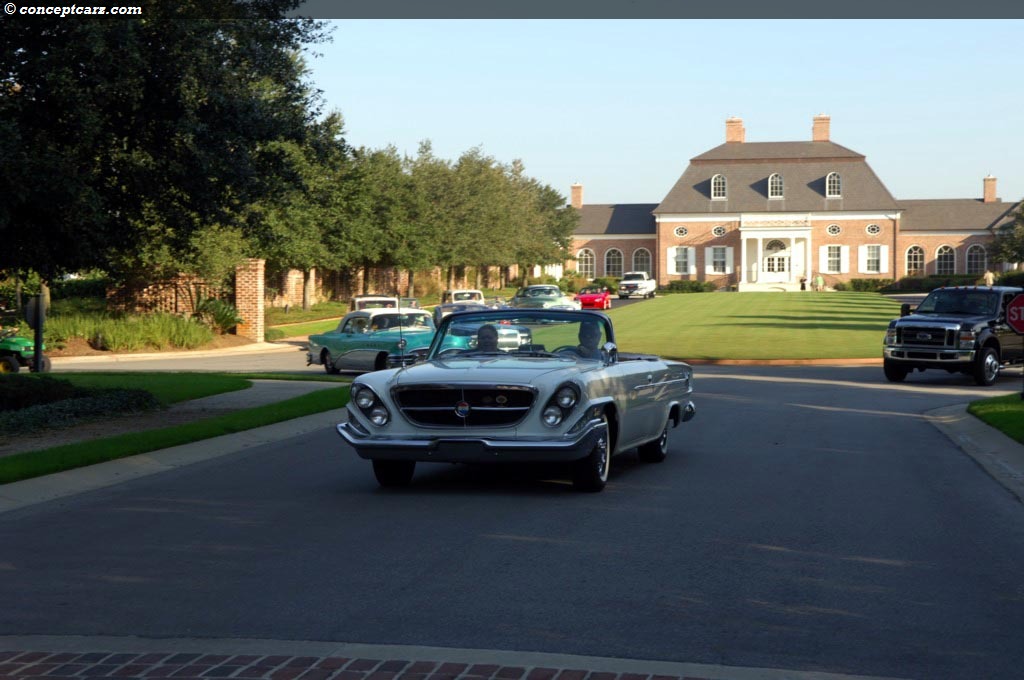
Convertible Hardtop
View info and history
The 1962 Chrysler 300H (along with the Newport, 300 (non-letter), and Sport Series) was built on a 122-inch wheelbase and had an overall length of 214.9 inches. (The New Yorker had a 126-inch wheelbase and was 219.3 inches in length, with the station wagon slightly longer at just over 220 inches). The suspension was independent at the front with torsion bars and a live rear axle with leaf springs. Drum brakes were at all four corners. The 413.3 cubic-inch eight-cylinder engine had overhead valves, solid valve lifters, two Carter four-barrel carburetors, five main bearings, 10.1:1 compression, and delivered 380 horsepower at 5,200 RPM. The engine was paired with a three-speed TorqueFlite automatic transmission. Chrysler 300 Letter Series
The Chrysler 300 'letter series' was produced from 1955 to 1965, with 16,981 units built during that time. An additional 501 'Hurst' 300 examples were built in 1970 but lacked the single-letter suffix of its forebears. The first of the letter series was the C-300 of 1955, with the 'C' designation applied to all Chrysler models and the '300' referenced its 300 horsepower engine. Built for homologation purposes, the OHV FirePower Hemi V8 displaced 331 cubic inches and used dual four-barrel carburetors. It had a race-profiled camshaft, two overhead valves per cylinder, and solid valve lifters.

Hardtop Coupe
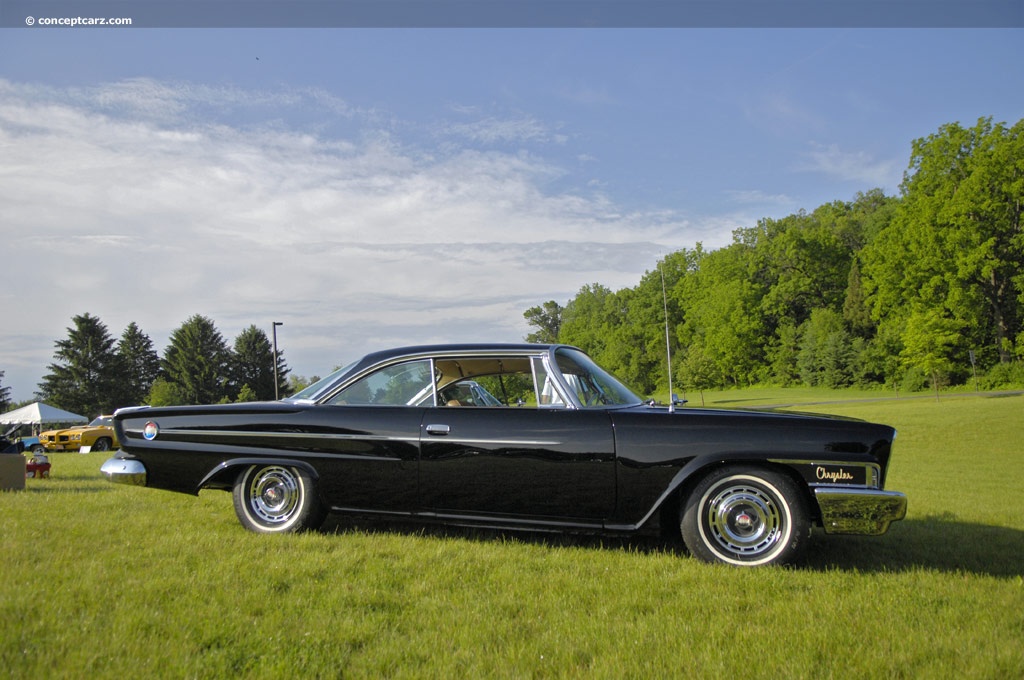
Hardtop Coupe
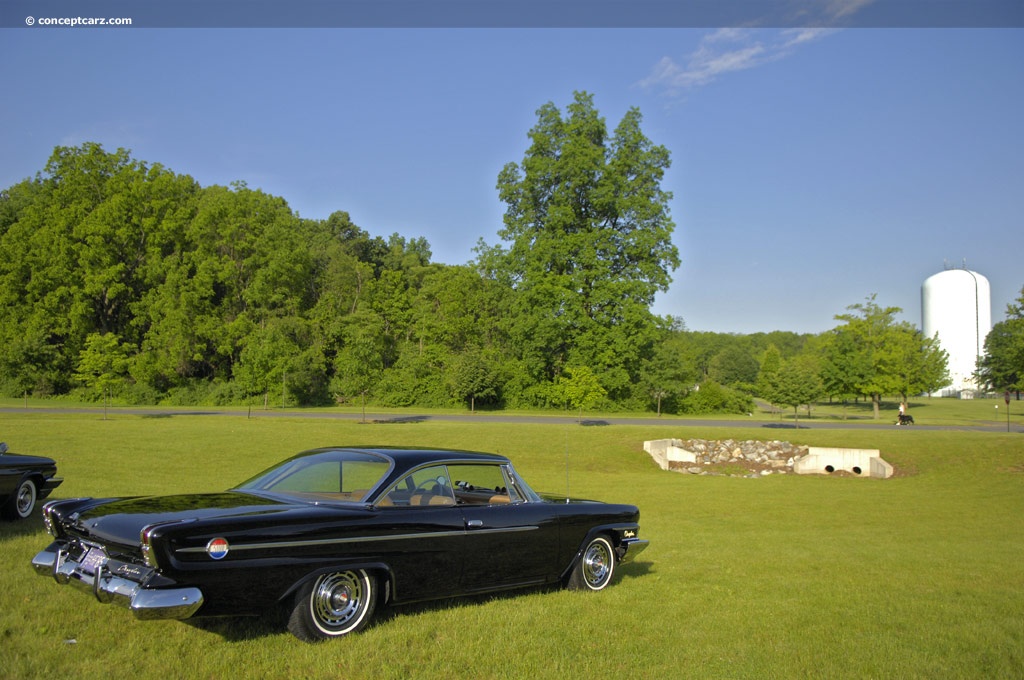
Hardtop Coupe

Hardtop Coupe
View info and history
by Daniel Vaughan | Apr 2019
Related Reading : Chrysler 300 History
of the original Hemi engine equipped with two four-barrel carbs, solid lifters, special manifolds, and enlarged dual exhausts. This vehicle gave the Chrysler Corporation a performance and sporty image, a much-needed persona in this post-World War II era. Many European manufacturers, such as Jaguar and MG, had introduced high-powered, small, responsive sports cars. American manufacturers countered....
Continue Reading >>
Continue Reading >>
Related Reading : Chrysler 300 History
In 2005, the wave of retro design that is still shaping American cars first washed over Detroit. American companies, with their stale product offerings, began looking towards their rich pasts to inspire new models with the design and flair of long-gone icons. It was in 2005 that Chrysler launched a modern iteration of the famed 300. The 300 name had actually been revived by Chrysler several years....
Continue Reading >>
Continue Reading >>
Similar Vehicles
Similarly Sized Vehicles
from 1962
Similarly Priced Vehicles
Chrysler Monthly Sales Volume
March 2023
31,899
1962 Chrysler 300H Vehicle Profiles
Recent Vehicle Additions
Performance and Specification Comparison
Price Comparison
$390 - $3,480
$4,125 - $4,875
300H Specification Comparison by Year
Year
Production
Wheelbase
Engine
Prices
Related Automotive News

CHRYSLER BRAND CELEBRATES 90 YEARS OF STYLE, ENGINEERING INNOVATION AND GROUNDBREAKING PRODUCTS
September 22, 2015 , Auburn Hills, Mich. - Chrysler Six, Airflow, Imperial, New Yorker, 300 and Town %26 Country are just some of the nameplates that mark the rich history of the Chrysler brand.
2015 marks the 90th anniversary of Chrysler, which...

Russo and Steele Collector Automobile Auctions Kicks Off 15th Anniversary with Eight Initial Offerings to Watch
Scottsdale, Arizona (December 1st, 2014) – For Enthusiasts – By Enthusiasts. ™ This is far more than a tagline at Russo and Steele Collector Automobile Auctions. Its a lifestyle, and we are gearing up to deliver that singular passion to the High...

Raw Power Has a Stamp of Its Own Muscle Cars Roar at Spring Classic Auction
What do you get when you bring the U.S. Postal Service and Dana Mecums Original Spring Classic Auction together at the State Fairgrounds — a Muscle Car Extravaganza!
Since it began 26 years ago, Mecums Spring Classic auction in Indianapolis...

Final Countdown Underway To South Florida's Premier Collector Car Auction
Auctions America kicks off its 2013 auction season, March 22-24 with its highly anticipated Fort Lauderdale Collector Car Auction
Celebrating its 11th year, the multi-day auction features more than 550 quality collector cars
Latest feature attr...

RICHARD PETTY DEDICATES MUSCLE CARS FOREVER STAMPS
Raw power gets a stamp of its own today as seven-time NASCAR National Champion Richard Petty helps dedicate the America on the Move Muscle Cars Forever stamps.
Petty, his son Kyle and Postmaster General Patrick Donahoe will dedicate the limited-edition...































